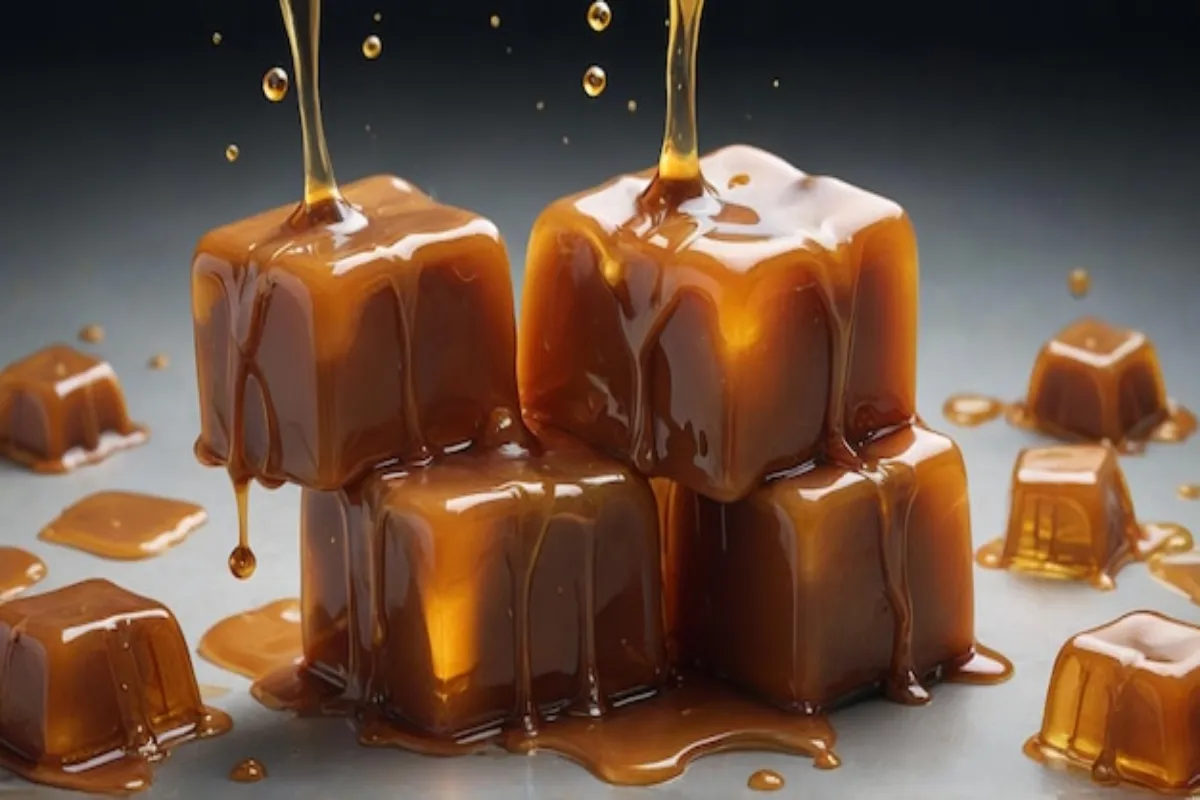Caramel and salted caramel are two of the most beloved flavors in the world of confectionery and desserts. While they might seem similar at first glance, their flavor profiles, ingredients, and uses can differ significantly. Whether you’re a fan of the classic, sweet richness of caramel or the modern, trendy complexity of salted caramel, understanding the differences between these two delicious flavors can help you choose the right one for your culinary creations.
What is caramel?
Caramel is a rich, sweet, and buttery substance created by heating sugar to its melting point, allowing it to turn a golden-brown color. The caramelization process is what gives caramel its signature taste—a deep, sweet, and slightly nutty flavor that can vary from light to dark depending on how long the sugar is cooked.
Caramel is usually made with:
- Granulated sugar
- Butter
- Heavy cream or milk
- Sometimes vanilla for extra flavor
When these ingredients are combined and heated, they form a luscious sauce or harden into candies, depending on how long they’re cooked.
Popular Uses for Caramel
Caramel has a multitude of uses in cooking and baking, especially in desserts. Some popular uses include:
- Caramel sauces for ice cream, pies, or cakes
- Caramel candies and toffees
- Caramelized fruits such as apples or bananas
- Caramel syrup in coffee and beverages
Caramel can be served in its liquid form, drizzled over desserts, or cooled to create chewy candies. For a deeper dive into traditional caramel recipes, you can visit this collection of caramel recipes to explore how caramel has been a staple in many desserts.
What is Salted Caramel?
Salted caramel is simply caramel that has been enhanced with the addition of salt. The basic ingredients for salted caramel are the same as traditional caramel, but with a twist. The addition of sea salt balances out the sweetness of the sugar and creates a more complex flavor profile that’s both sweet and salty.
Salted Caramel Ingredients:
- Sugar
- Butter
- Heavy cream or milk
- Sea salt or another type of high-quality salt
- Optional flavorings like vanilla
Why the Salt Matters
The addition of salt to caramel might seem like a small change, but it has a big impact on the flavor. Salt enhances the sweetness of the caramel while also adding a savory, rich layer that makes the flavor more balanced and nuanced. This is because salt has the ability to suppress bitterness and enhance sweetness on the palate. To learn more about the science behind how salt works with sweet flavors, check out this insightful explanation.
Popular Uses for Salted Caramel
Just like traditional caramel, salted caramel can be used in a variety of sweet treats. Some popular uses include:
- Salted caramel ice cream
- Salted caramel sauce on cakes and brownies
- Salted caramel popcorn
- Salted caramel chocolate bars
Salted caramel’s versatility and flavor complexity make it a favorite in gourmet desserts and snacks.
The Key Differences Between Caramel and Salted Caramel
Now that we’ve explored the basics of caramel and salted caramel, let’s dive deeper into the key differences between these two.

1. Flavor Profile
- Caramel: Purely sweet, with rich, buttery undertones. Depending on how it’s cooked, it can also have slight hints of bitterness from the caramelization of the sugar.
- Salted caramel: Sweet like caramel but with the addition of salt, which brings a savory counterbalance to the sweetness. The result is a more complex and sophisticated flavor.
2. Ingredients
- Caramel: Sugar, butter, cream, and optional vanilla.
- Salted caramel: The same base ingredients as caramel but with the addition of sea salt or another type of salt.
3. Culinary Uses
- Caramel is often used in more traditional recipes like caramel sauces, candies, and as a topping for ice cream.
- Salted caramel, with its trendy flavor profile, is more commonly found in gourmet dishes and desserts like salted caramel macaroons, chocolates, and artisanal ice creams.
The Science Behind Salt and Sweet
The reason salted caramel has become so popular can be traced back to the scientific principles of taste. Salt amplifies sweet flavors while also reducing bitterness, making salted caramel more enjoyable to a broader range of taste buds. Adding salt to caramel makes the sweetness less overwhelming, giving the flavor more depth and making it more enjoyable for people who might find caramel too sweet on its own.
The balance of sweet and salty is one of the key factors that make salted caramel a go-to ingredient in many modern desserts. To understand more about how salt works with sweet flavors, you can check out this article on sweet and salty flavor science.
Nutritional Differences Between Caramel and Salted Caramel
While the difference between caramel and salted caramel may be largely a matter of taste, there are some slight differences in their nutritional profiles due to the addition of salt.
Caramel Nutritional Information (Per Tablespoon):
- Calories: 60
- Sugar: 10g
- Fat: 3g
- Sodium: <5mg
Salted Caramel Nutritional Information (Per Tablespoon):
- Calories: 60
- Sugar: 10g
- Fat: 3g
- Sodium: 60mg
Both caramel and salted caramel are indulgent treats high in sugar and fat, but salted caramel has the added sodium content from the salt. While this addition doesn’t significantly alter the overall nutrition of the caramel, it is something to consider for people watching their sodium intake.
Caramel and Salted Caramel in Modern Cuisine
Both caramel and salted caramel are popular in today’s culinary world, but their uses can vary based on the flavor profile you’re looking for.
Caramel in Traditional Desserts
Caramel is a staple in traditional desserts like:
- Caramel flan
- Caramel apples
- Caramel sauces for ice cream and cakes
- Butterscotch (a close cousin to caramel but made with brown sugar and butter)
Salted Caramel in Modern Gourmet Desserts
Salted caramel is often seen as a more modern take on classic caramel and is used in gourmet desserts like:
- Salted caramel chocolate bars
- Salted caramel macarons
- Artisanal salted caramel ice creams
How to Make Caramel and Salted Caramel at Home
If you’re feeling adventurous, you can make both caramel and salted caramel at home with just a few simple ingredients. Here’s a quick guide to making both:
Basic Caramel Recipe:
- Ingredients:
- 1 cup of sugar
- 6 tablespoons of butter
- 1/2 cup of heavy cream
- Instructions:
- Heat the sugar in a saucepan over medium heat until it melts and turns golden brown.
- Add the butter and stir until melted.
- Slowly pour in the cream while stirring continuously until the mixture is smooth.
Salted Caramel Recipe:
Follow the same steps as above, but after incorporating the cream, add 1 teaspoon of sea salt. Stir well to ensure the salt is evenly distributed throughout the mixture.
Both caramel and salted caramel are relatively simple to make at home, and once you’ve mastered the technique, you can use them in countless recipes.
The History of Salted Caramel
While caramel has a history dating back centuries, salted caramel is a more recent innovation. French pastry chef Henri Le Roux is credited with inventing salted caramel in the late 20th century when he began adding salted butter to his caramel confections. His creation became a hit in France, and it wasn’t long before salted caramel took the world by storm.
Today, salted caramel is a major player in the world of sweets and desserts, frequently appearing in everything from gourmet chocolate bars to artisan ice cream.
Is salted caramel healthier than caramel?
From a health perspective, neither caramel nor salted caramel offers significant nutritional benefits. Both are high in sugar and fat, and while salted caramel has a more balanced flavor, the added salt can increase your sodium intake. For those who are conscious of their salt intake, it’s important to enjoy salted caramel in moderation.
Moderation is Key
Both caramel and salted caramel should be treated as occasional indulgences. While they are both delicious, they are also high in calories, sugar, and fat, making them best enjoyed in moderation. If you’re looking to reduce sugar or fat in your diet, there are low-sugar and low-fat versions of caramel available that still provide the sweet, rich flavor you love.
FAQs About Caramel and Salted Caramel
1. What is the difference between caramel and salted caramel?
The main difference is the addition of salt in salted caramel, which creates a more balanced and less sweet flavor compared to traditional caramel.
2. Why does salt enhance the flavor of caramel?
Salt amplifies sweetness while also adding a savory note that reduces any bitterness. This creates a more complex flavor experience.
3. Is salted caramel healthier than regular caramel?
Nutritionally, they are similar, although salted caramel contains more sodium. Both are high in sugar and fat, so neither is particularly healthy.
4. Which is more popular: caramel or salted caramel?
While salted caramel has gained popularity in recent years, especially in gourmet desserts, traditional caramel remains a staple in many classic recipes.
Conclusion
Both caramel and salted caramel bring their unique characteristics to the table. Caramel, with its pure sweetness, is a classic favorite in desserts and candies. Salted caramel, on the other hand, offers a more modern twist with its balance of sweet and salty flavors. Whether you prefer one over the other is a matter of taste, but both have a special place in the culinary world.
For those looking to explore more creative uses of caramel and salted caramel in their recipes, check out Sophie Recipes for innovative takes on these classic flavors.

